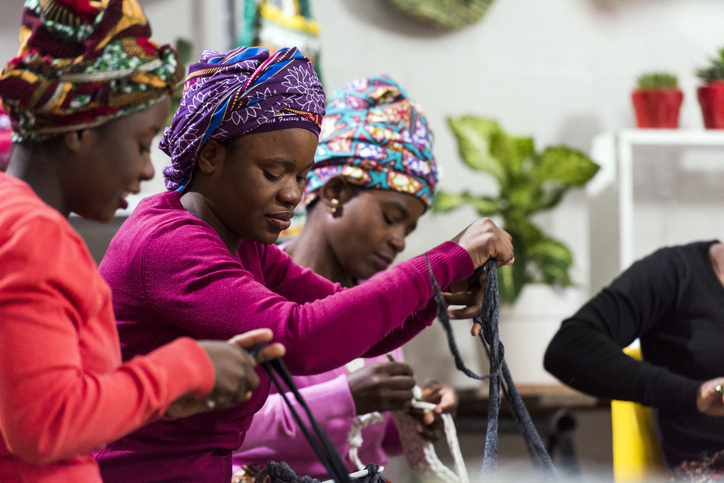Among the many development challenges discussed on GlobalDev over what is nearly five years of publishing, issues around migration, young people and the role of the private sector have been prominent. This column summarizes the key messages of the most popular pieces of 2022 in the three languages in which our blog operates.
As 2022 draws to an end, the GlobalDev team has looked back at your favorite articles of the year. Below are the most read articles in English, French and Spanish!
Child marriage in Pakistan: evidence from three development programs
This year, our most read article in English shed light on the causes, consequences, and potential ways to tackle child marriage in Pakistan, where, according to a survey conducted in 2017, nearly 40% of women had been married before the age of 18.
Albena Sotirova and her colleagues explain that ‘although fines and punishments exist, laws on child marriage have little impact as they are not well enforced.’ Social norms, religion but also economic reasons are among the main causes of child marriage in Sindh and Punjab, where it is usually the father and grandfather who arrange marriages.
Although according to the authors’ research, ‘young people in both Sindh and Punjab speak positively about some aspects of early marriage’, child marriage has been proven to cause mental and physical harm to girls, and also to have negative effects on boys.
Married girls typically become pregnant early, which leads to them dropping out of school. In case they do not conceive early or do not give birth to a son, they also face the risk of being treated harshly by their in-laws, ‘to the extent of not being allowed to speak in extreme cases.’ In parallel, ‘young men – who are seen as responsible for supporting their wives financially – often struggle to secure a stable income, leading to household poverty and stress. This in turn can increase the chances of domestic violence.’
The authors conclude that child marriage should be addressed through a multi-dimensional approach, seeking not only to help at-risk girls but also to influence social norms as well as leaders and decision-makers responsible for enforcing laws.
Entrepreneurship and development economics: convergence for better policy
In 2022, our French-speaking audience was most interested in the role of entrepreneurship in development. In their article, Jolanda Hessels and Wim Naudé argue that the persistence of weak entrepreneurship policies might be caused by the fact that ‘the positive impact of entrepreneurs is overestimated, and their detrimental effect underestimated.’
As they explain, these biases might exist due to the absence of a unified scientific approach that studies the intersection between entrepreneurship economics and development economics. Nonetheless, to determine the impact of entrepreneurship on development, they identify five areas in which the two fields are converging:
They first talk about externalities: ‘unintended consequences or actions not captured in the market price of the product or service provided.’ They argue that the more externalities an entrepreneur creates the more they drive development.
Second, they explain that the role of entrepreneurs varies across different stages of development. They give the example of Asia, where, in order to catch up with the first industrial revolution in Western Europe, entrepreneurs ‘identified, copied, and adapted existing technologies.’ Once rapid growth was underway, the most prosperous countries shifted to ‘innovation at the frontiers of knowledge.’
Third, they talk about the importance of ‘entrepreneurial ability’ in the transition to an innovation-driven economy.
Fourth, the authors pinpoint the central role of institutions in facilitating development. They give the example of the West in which the growth take-off ‘was accompanied by facilitating institutions (…) that encouraged and rewarded risk-taking by entrepreneurs.’
Last but not least, ‘there has been a recognition in entrepreneurship research that development is about more than monetary wealth and that subjective wellbeing matters as well.’
The authors conclude on the importance of these convergences in creating a better environment for start-ups, a more effective allocation of funds, and ‘better support of the kind of entrepreneurship that generates positive externalities.’
Migration: evidence from Mexico of the effects on sending countries
Our most read article in Spanish – and also our most read article overall – shifts the discussion about migration away from the effects it has on receiving countries to the impact on sending countries. Taking the example of Mexico, one of the largest sending countries in the world, Emily Conover and her colleagues explore the effects of the sex imbalance resulting from migration on labor markets.
As they explain, migrants from Mexico tend to be ‘men of working age with an average level of schooling.’ The large number of men leaving causes delay in marriage and sometimes leads to women never marrying or having kids. ‘This in turn could lead to women extending their time in schooling and university, and going into the labor market.’ Migration hence ‘affects the labor market, education, marriage, and fertility outcomes in the sending country.’
Looking back and forward
This year, more and more of you have been following our articles, we thank you very much for your continuous support and wish you a happy new year. 2023 will mark the fifth anniversary of the blog and we are preparing some surprises for the occasion – stay tuned!









